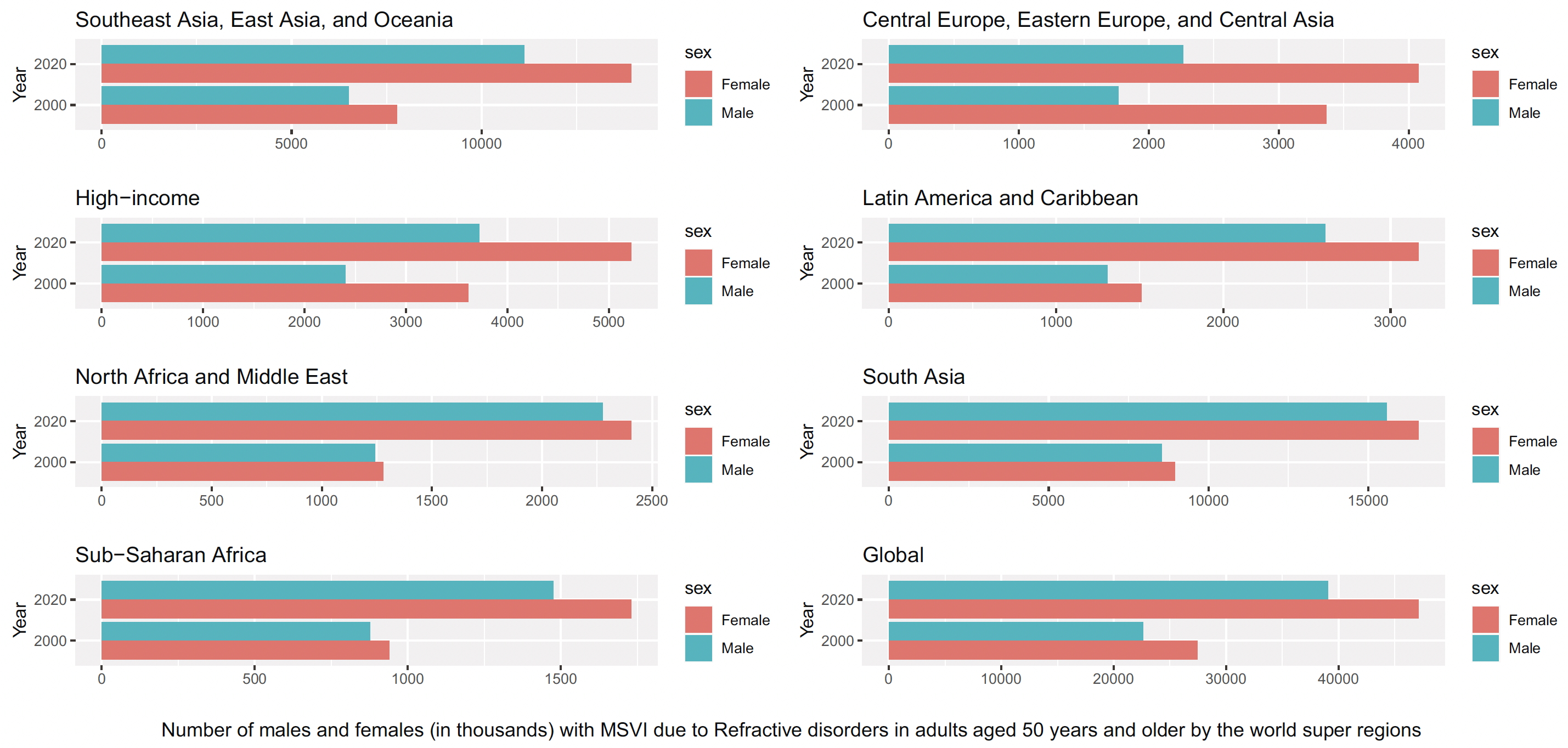The global burden of ocular disease remains a major concern to policymakers, as the ill effects of diabetic retinopathy or AMD (to name just a few) on quality of life, economic productivity and healthcare resources can be profound. So it’s all the more frustrating when something as simple as refractive error adds to the hardships of affected populations.
Recently, an international group of researchers published global estimates on the number of severe cases of uncorrected refractive error patients in a meta-analysis from 2000 to 2020 in order to assess the prevalence of undesirable visual outcomes.1
Researchers collected data from a total of 243 studies from 73 countries. Each study reported on the number of men and women with blindness (visual acuity of <3/60 on the Snellen chart), moderate to severe visual impairment (visual acuity of <6/18 to ≥3/60), or near visual impairment from uncorrected presbyopia (near visual acuity <N6/N8 at 40cm when BCDVA ≥6/12).
 |
| Uncorrected refractive error is the leading cause of vision impairment around the world, impacting millions of adults and children. After adopting the goals set by the WHO, the World Health Assembly hopes to reduce avoidable vision loss by setting a global target for a 40% increase in effective refractive error coverage by 2030. This chart from the study shows the number of men and women with moderate to severe vision impairment due to uncorrected refractive error in 2000 and 2020 by seven World GBD super-regions and globally. Note that scales (values should be multiplied by 1000) are not the same between charts, but rather serve to highlight the differences across the time period and sex differences within GBD super-regions. Photo: Eye. July 4, 2024. Click image to enlarge. |
According to the researchers’ estimates for 2020, 3.7 million individuals were deemed blind, and 157 million more were diagnosed with moderate to severe vision impairment as a result of their uncorrected refractive error. This data would suggest that the prevalence of blindness increased by 21.8% and of visual impairment by 72% since 2000. When broken down by age group, the researchers discovered that patients who are 50 years and older make up 2.29 million cases of blindness and 86.1 million cases of vision impairment in 2020.
“Encouragingly, the age-standardized prevalence of blindness due to uncorrected refractive error in those aged 50+ years has decreased substantially from 2000 to 2020, potentially reflecting the targeted efforts countries have adopted to tackle severe sight loss,” stated the researchers in their paper for the British journal Eye. “In contrast, the age-standardized prevalence of moderate to severe vision impairment due to uncorrected refractive error in those aged 50+ years only decreased modestly between 2000 and 2020.”
The data was separated by super-region to assess the regional trends of the effects of refractive errors. South Asia (12.71%) had the highest prevalence of blindness, followed by Southeast Asia, East Asia and Oceania (9.34%). Additionally, women are disproportionately affected around the world, with a higher prevalence of visual impairment in super regions such as Central Europe Eastern Europe and Central Asia, North Africa and Middle East, and Latin America and the Caribbean. The prevalence of blindness in the high-income super-region increased for women by 1% compared to men with a 0.1% decrease.
Globally, the prevalence of presbyopia is growing, and cases of near vision impairment have increased tremendously since 2000 (+75.3%). Currently, it is estimated that 419 million presbyopic patients suffer some type of vision impairment. The researchers reported that 70% of global cases are represented by two super-regions: South Asia (~124 million cases) and Southeast Asia, East Asia and Oceania (~169 million cases). “The large burden of uncorrected presbyopia may in part reflect a view that correction for near vision impairment is somehow less important than for distance vision impairment, but studies have shown that vision impairment from uncorrected refractive error affects the quality of life to a similar degree whether at distance or near vision impairment,” stated the researchers in their paper.
This study was conducted to address what regions are struggling to meet the needs of their patients and which direction the global prevalence of uncorrected refractive errors will continue in the future. However, this study could not obtain data from smaller, less-populated areas within super-regions. The researchers believed that the information provided to them was too sparse that they could not include results on mild vision impairments. And with the COVID-19 pandemic altering healthcare in 2020, the resulted prevalence of these conditions could have been skewed. The researchers noted that there have been reports that lifestyle changes during lockdown may have attributed to an increase in myopia.2
“While progress has been made in the last two decades, a reduction in the burden of vision impairment from uncorrected refractive error can be realized by adding refractive services to universal health coverage and otherwise improving availability of, and access to, spectacle provision,” concluded the researchers in their paper. “Though the need is greater in some global regions, uncorrected refractive error has not been fully addressed anywhere, and the resulting productivity losses and reduction in quality of life should not be overlooked for any country.”
1. Vision Loss Expert Group of the Global Burden of Disease Study, GBD 2019 Blindness and Vision Impairment Collaborators. Global estimates on the number of people blind or visually impaired by uncorrected refractive error: A meta-analysis from 2000 to 2020. Eye. July 4, 2024. [Epub ahead of print]. 2. Li M, Xu L, Tan CS, et al. Systematic review and meta-analysis on the impact of COVID-19 pandemic-related lifestyle on myopia. Asia Pacific Journal of Ophthalmology 2022;11:5:470-480. |


